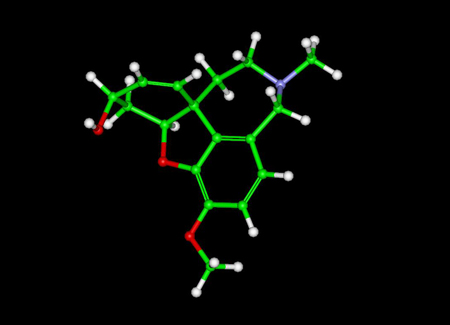Galantamine or galanthamine (trade names: Nivalin, Razadyne, Razadyne ER, Reminyl) is a chemical used for the treatment of mild to moderate Alzheimers disease and various memory impairments. It is an alkaloid that is obtained synthetically or from the bulbs and flowers of the Caucasian snowdrop Galanthus woronowii (Amaryllidaceae) and related genera like Narcissus (daffodil), Leucojum (snowflake) and Lycoris including Lycoris radiata (Red Spider Lily). The active ingredient was isolated by prof. Paskov 1959 (Sopharma, Bulgaria) from a species tradionally used as a popular medicine in Eastern Europe and thus the idea for developing a medicine from these species seems to be based on the local use (ie, an ethnobotany-driven drug discovery).[1][2] It has been used for decades in Eastern Europe esp. in the symptomatic treatment of polio (poliomyelitis) and was later developed by Janssen Pharmaceutica into an Alzheimer medication. In the US it has been sold as a dietary supplement for memory and dream support prior to being approved as a drug by the FDA.
Pharmacology
Galantamine in its pure form is a white powder. Galantamine is a competitive and reversible cholinesterase inhibitor. It is believed it works by enhancing cholinergic function by increasing the concentration of acetylcholine in the brain. The atomic resolution 3D structure of the complex of galantamine and its target, acetylcholinesterase, was determined by X-ray crystallography in 1999 (PDB code: 1DX6; see complex).[3] There is no evidence that galantamine alters the course of the underlying dementing process.[4] Galantamine has also shown activity in modulating the nicotinic cholinergic receptors to increase acetylcholine release.[5]Pharmacokinetics
Absorption of galantamine is rapid and complete and shows linear pharmacokinetics. It is well absorbed with absolute oral bioavailability between 80 and 100%. It has a half-life of seven hours. Peak effect of inhibiting acetylcholinesterase was achieved about one hour after a single oral dose of 8 mg in some healthy volunteers.
Plasma protein binding of galantamine is about 18%, which is relatively low.
Metabolism
The major route of metabolism for galantamine is through the liver, this accounts for approximately 75% of the total metabolism of galantamine. Hepatic cytochrome P450 (CYP) isoenzymes are the active enzymes for this metabolic route. In vitro studies have shown that CYP2D6 and CYP3A4 are involved in galantamine metabolism.
For Razadyne ER (the once-a-day formulation), CYP2D6 poor metabolizers had drug exposures that were approximately 50% higher than for extensive metabolizers. About 7% of the population has this genetic mutation, however because the drug is individually titrated to tolerability, no specific dosage adjustment is necessary for this population.
Clinical use
Indications
Galantamine is indicated for mild to moderate Vascular Dementia and Alzheimer's.[6][7]
Available forms
The product is supplied in twice-a-day tablets, once-a-day extended release capsules, and in oral solution. The tablets come in 4 mg, 8 mg, and 12 mg forms. The capsules come in 8 mg, 16 mg, and 24 mg forms.
Adverse events
In clinical trials, galantamine's side effect profile was very similar to that of other cholinesterase inhibitors, with gastrointestinal symptoms being the most notable and most commonly observed. In practice, some other cholinesterase inhibitors might be better tolerated; however, a careful and gradual titration over more than three months may lead to equivalent long-term tolerability.[8]
Caution
The U.S. Food and Drug Administration (FDA) and international health authorities have published an alert based on data from two studies during the treatment by galantamine of mild cognitive impairment; higher mortality rates were seen in drug-treated patients.(14) On April 27, 2006, FDA approved labeling changes concerning all form of galantamine preparations (liquid, regular tablets,and extended release tablets) warning of the risk of bradycardia (and sometimes atrioventricular block,especially in predisposed persons). At the same time, the risk of syncope seems to be increased relative to placebo.[15] These side effects have not been reported in any other studies except in mild cognitive impairment.
References
- Heinrich, M. and H.L. Teoh (2004) Galanthamine from snowdrop – the development of a modern drug against Alzheimer's disease from local Caucasian knowledge. Journal of Ethnopharmacology 92: 147 – 162. (doi:10.1016/j.jep.2004.02.012)
- Scott LJ, Goa KL. Adis Review: Galantamine: a review of its use in Alzheimer's disease. Drugs 2000;60(5):1095-122
- Greenblatt, HM, Kryger, G, Lewis, T, Silman, I, Sussman, JL "Structure of acetylcholinesterase complexed with (-)-galanthamine at 2.3Å resolution" FEBS Lett 1999; 463, 321-26. PMID 10606746
- Ortho-McNeil Neurologics, "Razadyne ER US Product Insert", May 2006. [1]
- Woodruff-Pak DS, Vogel RW 3rd, Wenk GL, "Galantamine: effect on nicotinic receptor binding, acetylcholinesterase inhibition, and learning" Proc Natl Acad Sci U S A. 2001 Feb 13;98(4):2089-94.
- Galantamine Benefits Both Alzheimers Disease and Vascular Dementia
- Galantamine Improves Attention in Alzheimer's
- Birks J. "Cholinesterase inhibitors for Alzheimer's disease." Cochrane Database Syst Rev. 2006 Jan 25;(1):CD005593.
- Thomas Yuschak (2006). Advanced Lucid Dreaming (1st ed.). Lulu Enterprises.
- Thomas Yuschak (2007). Pharmacological Induction of Lucid dreams. http://www.advancedld.com/f/Pharmacological_Induction_of_Lucid_Dreams.pdf.
- "Substances that enhance recall and lucidity during dreaming". Stephen LaBerge - US Patent. http://www.freepatentsonline.com/20040266659.html. Retrieved 2007-10-29.
- "Galantamine LDS Profile". Yuschak LDS Profiles. http://www.advancedld.com/galantamine.html. Retrieved 2007-10-29.
- Galantamine Protects Neurons and Memory Following Brain Injury
- "FDA ALERT: Galantamine hydrobromide (marketed as Razadyne, formerly Reminyl) - Healthcare Professional Sheet". Postmarket Drug Safety Information for Patients and Providers. Food and Drug Administration. March 2005. http://www.fda.gov/Drugs/DrugSafety/PostmarketDrugSafetyInformationforPatientsandProviders/ucm126140.htm. Retrieved 2009-07-30.
- "Safety Labeling Changes Approved By FDA Center for Drug Evaluation and Research (CDER)". MedWatch, The FDA Safety Information and Adverse Event Reporting Program. Food and Drug Administration. April 2006. Archived from the original on 2007-10-09. http://web.archive.org/web/20071009145003/http://www.fda.gov/medwatch/safety/2006/apr06.htm.

